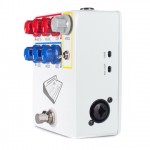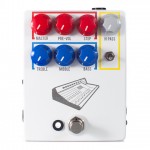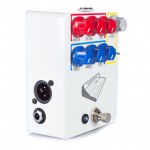
BRAND: JHS Pedals
MODEL: Colour Box
COST: $399
WHAT IT IS:
The Colour Box is a studio grade pre-amp designed to be the equivalent of a single channel strip on a classic Neve soundboard. These consoles have been found in legendary recording studios like Abbey Road in London and Studio 101 in Los Angeles. The pedal was created to give you the sound of plugging you instrument direct into a desk instead of going through an amp.
I say instrument instead of guitar on purpose. Anything you can plug in can be used with the Colour Box, with both 1/4 inch and XLR ins and outs, the Colour box can be used with Microphones, Guitars, Basses, Keys, Accordions, Violins, Theremin, and whatever else you can come up with.
Since it’s a “desk in a box” you can use it for tone shaping and EQ, or you can crank the pre-volume and turn the Colour Box into a gain pedal giving you everything from clean boost to OD to Distortion, to Fuzz. The Colour Box can find a home at almost every point on your signal chain.
Over the last month or so that I’ve had this pedal we’ve tested it on everything. Electric Guitar, Bass, and acoustic guitars from the crappy ones with low grade electronics to my Martin HD-28V with K&K Trinity pickups installed.
Before the testing began I asked myself a set of questions by which I would judge the pedal. Here’s the results:
Where will it go in the signal chain?
The Colour Box can go almost anywhere in your signal chain. The determining factor is need and function. If you plan on using it for overdrive or distortion then you’d run it with your gain pedals. If you plan on using it for fuzz then you can probably put it with either your gain pedals or before everything like with a traditional fuzz. Normally fuzz goes at the front but with the Colour Box, I think you’ll get away with it.
If you are using it for EQ then you can put it either after the gain pedals or at the very end of your chain.
Personally, I didn’t put any Velcro on it, and while it lives in my pedalboard case, it doesn’t live on my pedal board. I run it at the end of the chain, after my board then I run the 1/4 inch lead cable to my amp and an optional XLR out direct to the desk for a stereo mix. But by keeping it separate from my board, it gives me the option of running it in front of everything for fuzz or other gain effects.
Will it replace an amp?
You can use the Colour Box in place of an amp if you want. What I love is that it’s not trying to be something it’s not. It’s not trying to emulate a tube amp, it IS a soundboard channel strip. The more I played with it using this functionality, the more I realized how familiar a sound going direct in was to my ears, and how many recordings, both modern and classic, have used this technique.
Recently, I traveled out of state to lead worship, and I didn’t want to bring my amp on the road, which was the perfect test to see how the Colour Box would hold up. On it’s own, it sounds just fine. It’s not my Princeton Reverb, but it sounds really good. If I was just in the band I could probably get away with the Colour Box alone. However, when leading a song as the band leader, I found that I wanted the “grit” of a tube amp. In this situation, I found that my JHS Superbolt which is designed to emulate a Supro amp, or my Matthews Klone (the original Klon Centaur on which the MK is based was designed to sound like a cranked Fender Twin) did the job just fine. Will it replace my amp? No, but it makes my amp sound better and it’s nice to know that I can get away w/o an amp if I need to.
How is it with acoustic guitar?
When we plugged in a lower end acoustic guitar we found that the Colour Box did a lot to improve the sound. On it’s own it became passable, and in a full band it probably would’ve blended in very nicely. I also found this is a spot where the High Pass filter really shines.
I had some issues with my personal guitar ( a Martin HD-28V) where it distorted, but after some personal experimenting and some email consultation from the guys at JHS, I figured out that it was a combination of issues including the gain/trim being too ‘hot’ on the soundboard and my aftermarket pick ups “pre amp” not working well with another pre amp. I’m sharing this in the review because I want to note that there is a learning curve with the Colour Box and also that while it’s a useful tool, I’ve found that if it was just for my acoustic, I’d probably prefer what I already have for live use and only use the Colour Box for recording.
How does it work with other instruments?
Great. There’s demos online of the Colour Box with Keys and vocals and it sounds fantastic. If you plugged in something else, I’m sure you’d get a great sound once you dialed it in.
Does it actually make me sound better?
Short Answer: YES!
Long Answer:
When I got the pedal I plugged it in after my pedalboard going into my amp. It just flat out sounded better. This was with nothing dialed in and all the knobs at noon. As I began to tweak the sound only increased in quality.
When we plugged a bass guitar in, our sound guys were ready to place their order for one of their own. There’s just no question that this thing gives you an over all increased sound quality.
Is it really unique enough to justify cost?
This thing is unique. There are other guys making studio grade pre’s and a few who are making them with guitar in mind. But when I searched for a similar product I either found things that were cheaply made, meant only for the studio, or so expensive that only a pro level studio or major touring musician would think to own them. There were a few that came close, but nothing exactly like the Colour Box, especially in it’s attempt at versatility (both in sound and in instrument use) and it’s sound homage to the Neve mixing board. So in that sense the Colour Box first in it’s class and very unique.
Does it justify it’s cost? When you factor in components (the Lundahl transformer alone costs as much as some effects pedals) combined with the cost of boutique fuzz pedals and pre amps, the cost is very reasonable.
Does it inspire you to play?
This is a question I often ask before buying a new piece of gear. Does it inspire me to make or create something new? Normally if the answer is no then I tend to walk away, but in the case of the Colour Box, it’s not that it inspires me so much as it makes what I create sound better. No doubt if I was opting to use the fuzz/gain aspects more then it would cause me to venture into some interesting places, but for church music, it just gives my tone a clarity that it didn’t have before. If I like how I sound, I’m going to want to play more, period.
PROS:
-Versatility: Fuzz, distortion, overdrive, EQ, preamp, amp replacement with XLR and ¼ inch ins/outs.
-Sound Quality: You will sound better with this plugged in.
-EQ: I was able to take bad tones and frequencies out of a low grade acoustic guitar and add good tones and frequencies to my amplifier.
-Size: A studio grade pre amp in a pedal? Can’t beat that.
-Multi-function: You can use it with your guitar, amp, bass, acoustic instrument, vocals, keys, accordion, mandolin, banjo or anything else you can think to plug in.
CONS:
-Price: I’m told JHS wanted the pedal to come in closer to $300 than $400, but that cost of parts (the Lundahl transformer along costs as much as some pedals) prevented that. If this pedal had even been $50 less I probably wouldn’t have paused as much as I did before purchase.
-Power: This much function requires more power. The Colour Box runs off 18volts. JHS provides a power supply but it’s one more thing to plug in and if you want to use your PP2 it means using two power slots. I’m not knocking JHS for going with the 18v power supply. If the pedals needs it, it needs it. It’s just a funcational issue that should be noted.
HOW WOULD YOU USE IT FOR WORSHIP?:
I leave it off my board (although it travels in the same case). I run my pedal board into it and use the stereo outs to run the lead cable to the amp and the XLR to the desk. For me, that alone is worth the price. But since it’s not on the board, I’m free to move it to the front of my chain for fuzz and gain options.
Also, if your church doesn’t allow amps, this is a viable option for amp replacement, especially if you pair it with a “amp in a box” pedal like a Wampler ’65 or JHS Superbolt.
FINAL VERDICT:
It’s an expensive pedal, there’s no way around it, and there are guys out there who will look at this and say “sounds cool, but I’d never pay that much.” Fair enough. If you were in a bar band playing classic rock covers then I’d say the Colour Box is a no brainer. Direct in tone is essential to certain songs by bands like the Beatles, Neil Young or others. Newer artists like Jack White, Radiohead and Spoon also make heavy use of it.
For a church musician, the Colour Box offers innovative solutions for many problems and issues common to us, but does so at a price point that may not make it a clear cut choice.
For church sound guys, especially with bass guitar, the Colour Box will make you drool. It can be used as a preamp for bass, a DI for keys or acoustic guitar, or an amp replacement for electric.
When I bought mine, I was unsure if it would make a big enough difference for me to keep it instead of trying to flip it. Turns out it did. As a preamp, EQ, amp replacement, DI, and gain pedal the Colour Box covers a LOT of ground for me and it looks like it’ll be a fixture for a long time to come.




